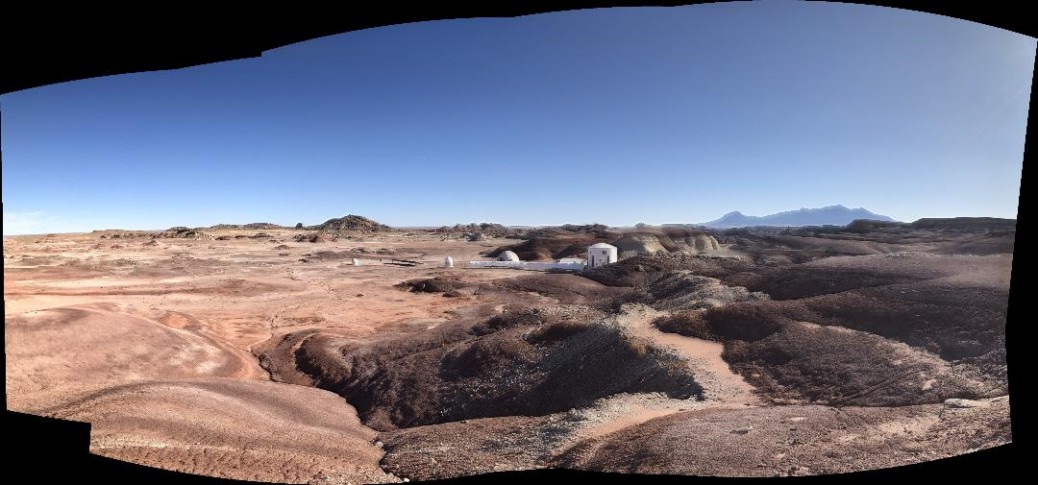From Bake-off to take-off: UC student goes to ‘Mars’
4 November 2019
New Zealand Astrobiology Network in collaboration with Mars Society New Zealand, Mars Society Australia and the University of Canterbury (UC) have selected a student to be part of Crew 215 of the Mars Desert Research Station simulation.
New Zealand Astrobiology Network is very grateful to the University of Canterbury for supporting the student to attend the MDRS mission. This is the 5th mission to MDRS that has New Zealand participation.
Haritina Mogoșanu, Executive Director NZAN

Last year, Larissa Wilson starred in TV contest The Great Kiwi Bake-Off, this month the UC Mechanical Engineering BE(Hons) student From Bake-off to take-off: will spend two weeks at the Mars Desert Research Station in Utah, United States.
The station, owned and operated by the Mars Society, is a space analogue facility supporting Earth-based research in pursuit of the technology, operations and science required for human space exploration. Set in a Utah desert much like the Mars surface, the station offers opportunities for field studies as they would be conducted during an actual space mission.
“I am incredibly excited to take part in a simulated Mars mission with a crew of talented and knowledgeable people from around Australia.”
“I have loved the idea of space exploration and learning about outer space since I was a small child. I feel incredibly honoured to have been selected as part of Expedition Boomerang and I’m eager to experience what being an early explorer of the red planet might be like.”
Larissa Wilson
She hopes young women and girls feel encouraged to be involved in any line of work they want.
“I know that I would have been excited and inspired to see a woman involved in a project like this when I was a child.”
Larissa Wilson
The opportunity arose from collaboration between UC academics Associate Professor Allan Scott and Senior Lecturer Dr Matthew Hughes, both from UC’s Civil and Natural Resources Engineering department, and Haritina Mogoșanu, Executive Director of the New Zealand Astrobiology Network and president of the New Zealand Mars Society.
The simulated Mars expedition will be an opportunity for Larissa to experience first-hand the challenges of conducting in situ resource utilisation assessments, as well as other research.
“Some of these projects will require me to take on a lot of new information and I hope to learn about the application of a range of fields of science such as geology and human biology in an ‘alien’ setting,” Larissa says. “I also hope to complete some of my own research, possibly in the realm of acoustics engineering which is the field in which I plan to work.”
New Zealand has been involved with the Mars Desert Research Station since 2011 according to Ms Mogoșanu, who has been on three similar missions and organised a fourth.
“It’s an exciting and valuable opportunity to connect with the Mars community and the science and engineering it will take us to get there,” Ms Mogoșanu says. “It is involvement in these sort of activities that keeps young New Zealanders connected to the larger space research community. For a young woman like Larissa, this is a fantastic opportunity to learn first-hand about the hurdles of going to Mars, and perhaps one day to be part of making that happen.”
Haritina Mogoșanu
Larissa’s simulated Mars mission extends research that Assoc Prof Scott and Dr Hughes have been conducting, focusing on construction materials and ecosystem approaches to space habitation.
“In order for humans to live viably long-term on the Moon and Mars, we will have to harness local resources to obtain construction materials, water and the nutrients necessary for plant and food production” says Dr Hughes. “This is called in situ resource utilisation, and will be essential for sustainable and resilient colonies in these extreme environments.”
Dr Matthew Hughes
“We’re developing a new type of concrete based on a form of magnesium,” says Assoc Prof Scott. This Martian concrete will be used for base and infrastructure construction, including rocket landing pads.
“We can develop new construction materials, use 3-D printing or modular building options using our magnesium concrete. Once we get the soil sorted we can create a greenhouse for Mars and jumpstart an ecosystem.”
Assoc Prof Allan Scott
Larissa’s simulated Mars expedition is supported by UC’s College of Engineering. Upon her return, Larissa will conduct a range of outreach and education activities to share her exciting story and inspire others.
For more information contact:
· UC Communications team, media@canterbury.ac.nz, Ph: (03) 369 3631 or 027 503 0168 (to request an interview with Larissa Wilson)
· Associate Professor Allan Scott, Civil and Natural Resources Engineering, allan.scott@canterbury.ac.nz, Phone: +6433692089
· Senior Lecturer Dr Matthew Hughes, Civil and Natural Resources Engineering, matthew.hughes@canterbury.ac.nz, Phone: +6433694599
· Haritina Mogosanu, Executive Director New Zealand Astrobiology Network, haritina@astrobiology.nz, Phone: +64212692908








